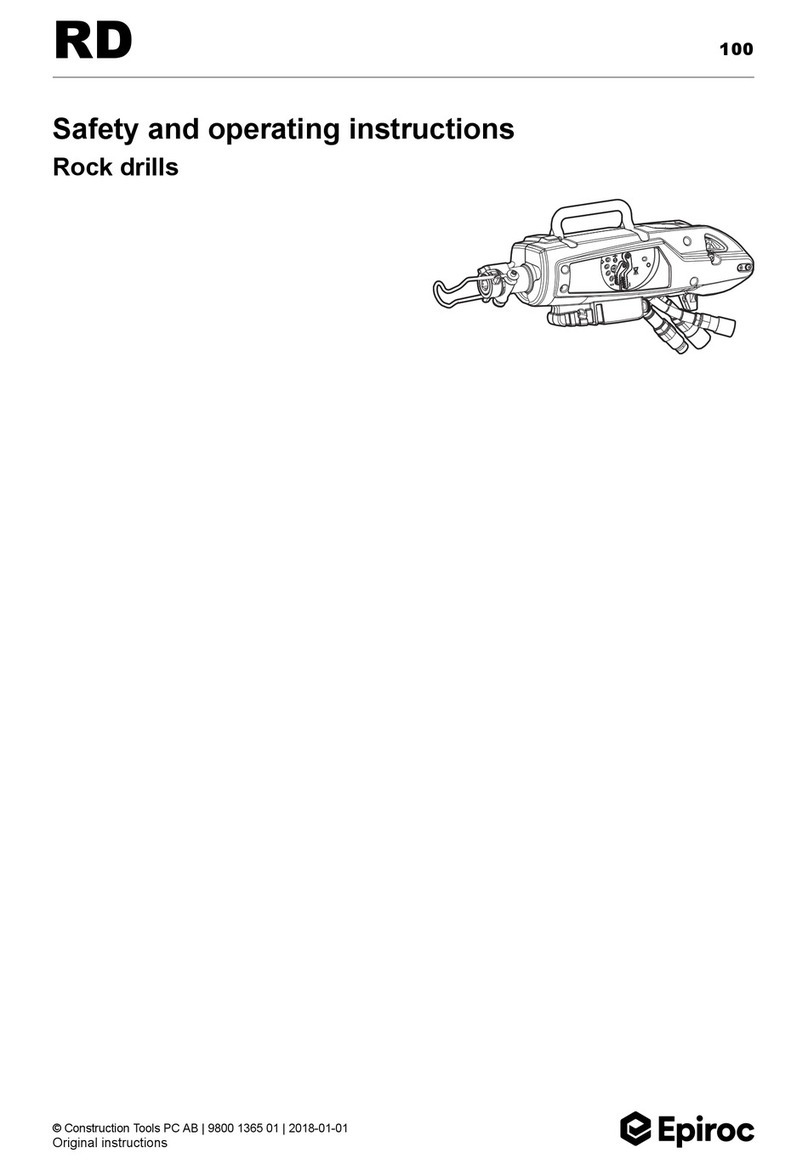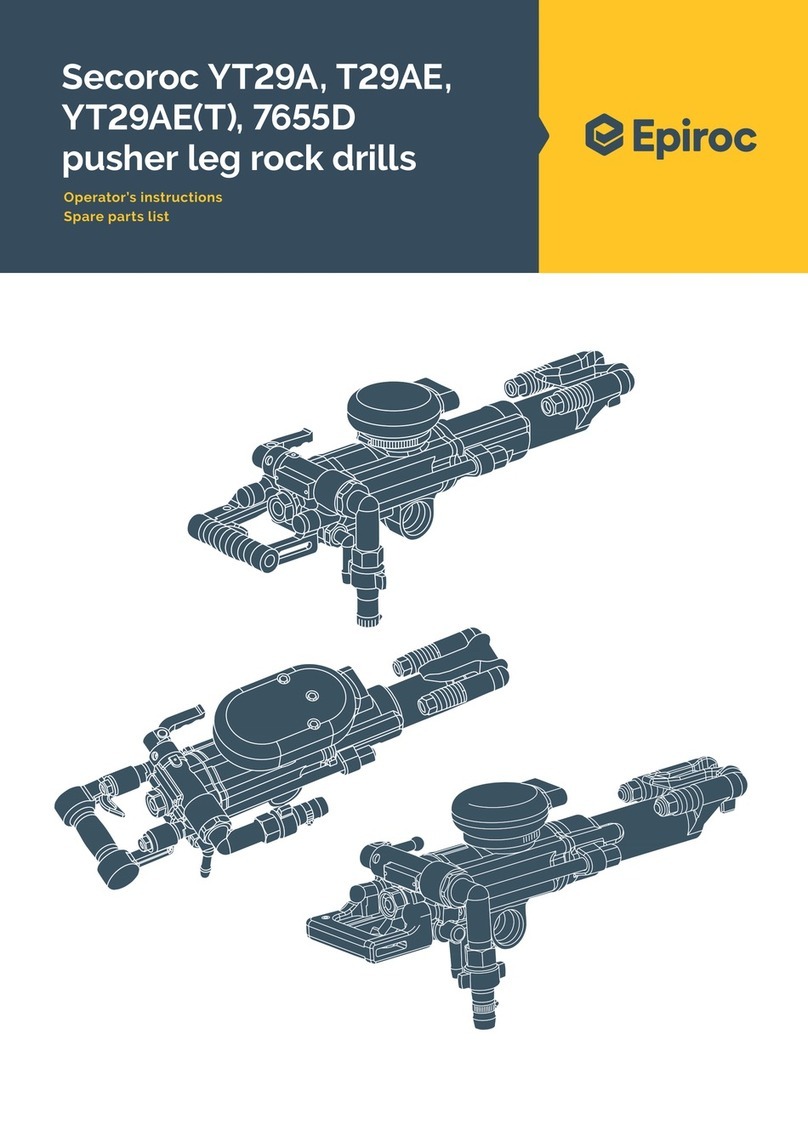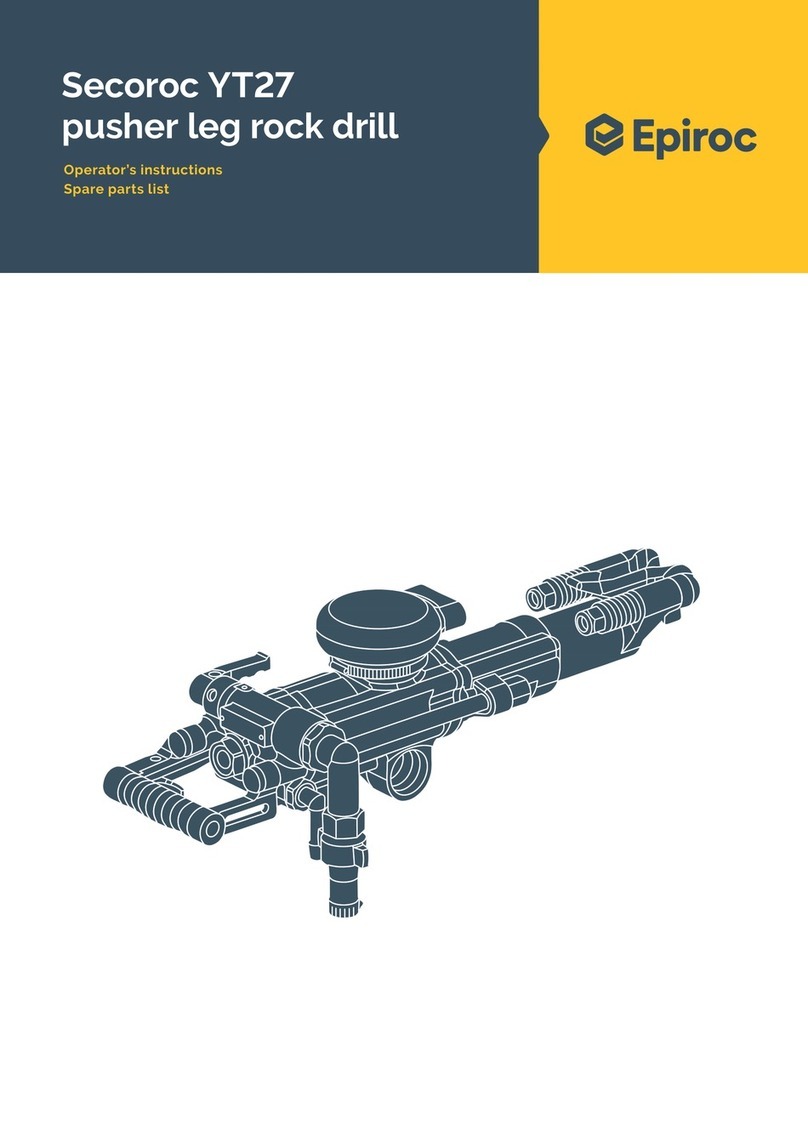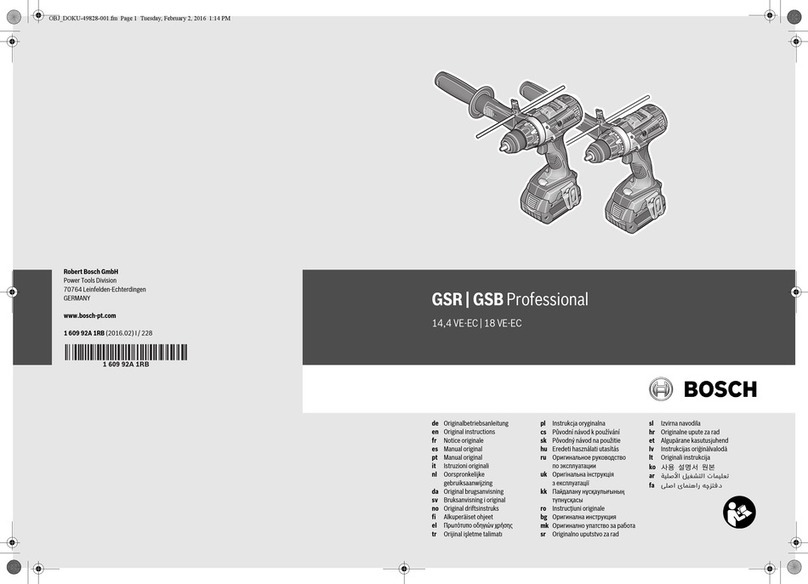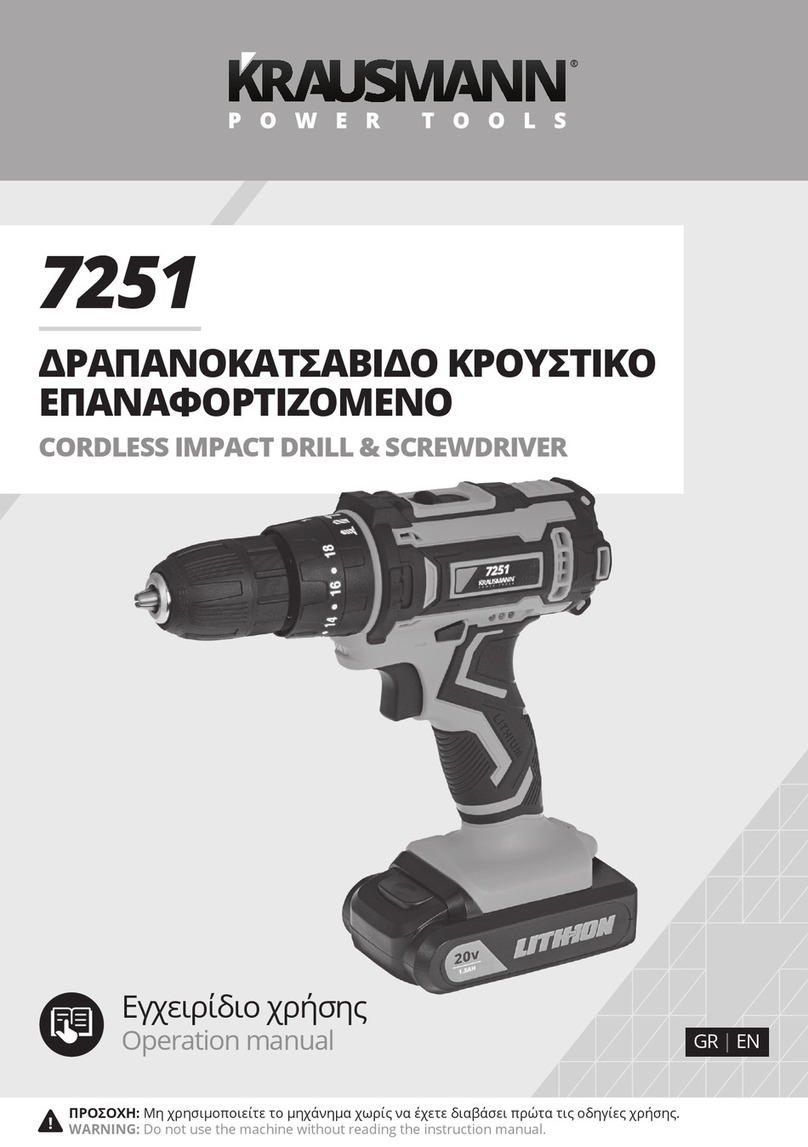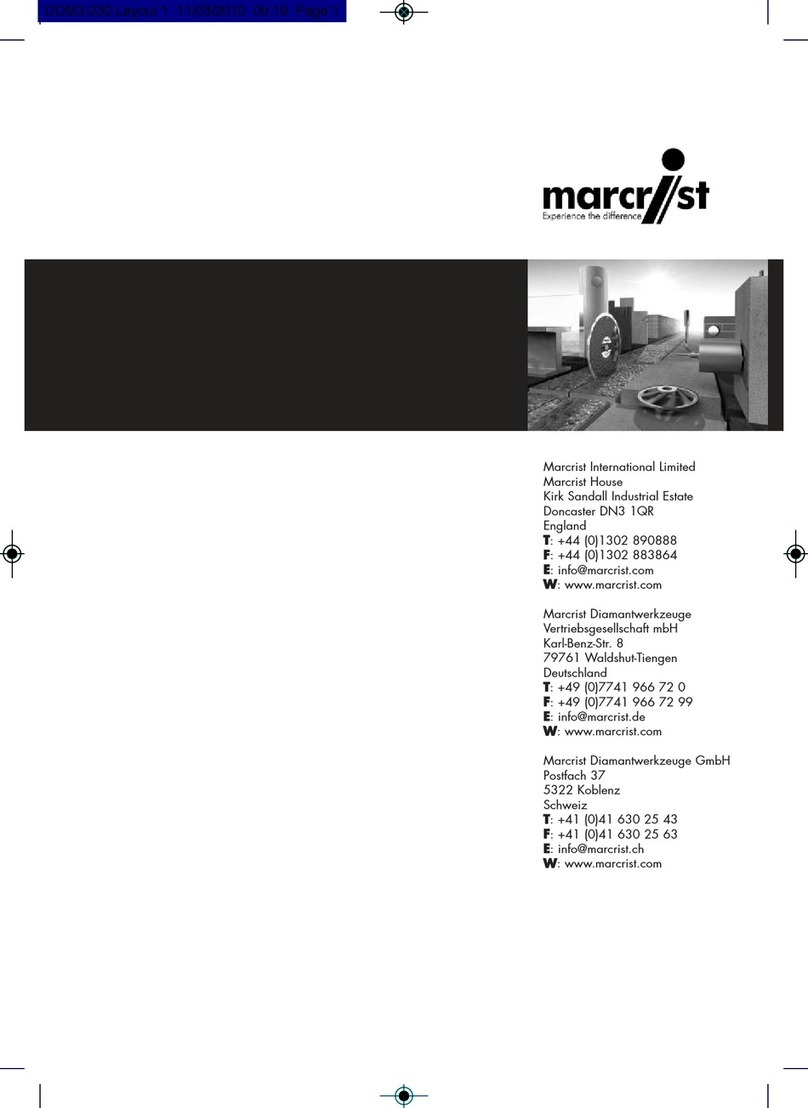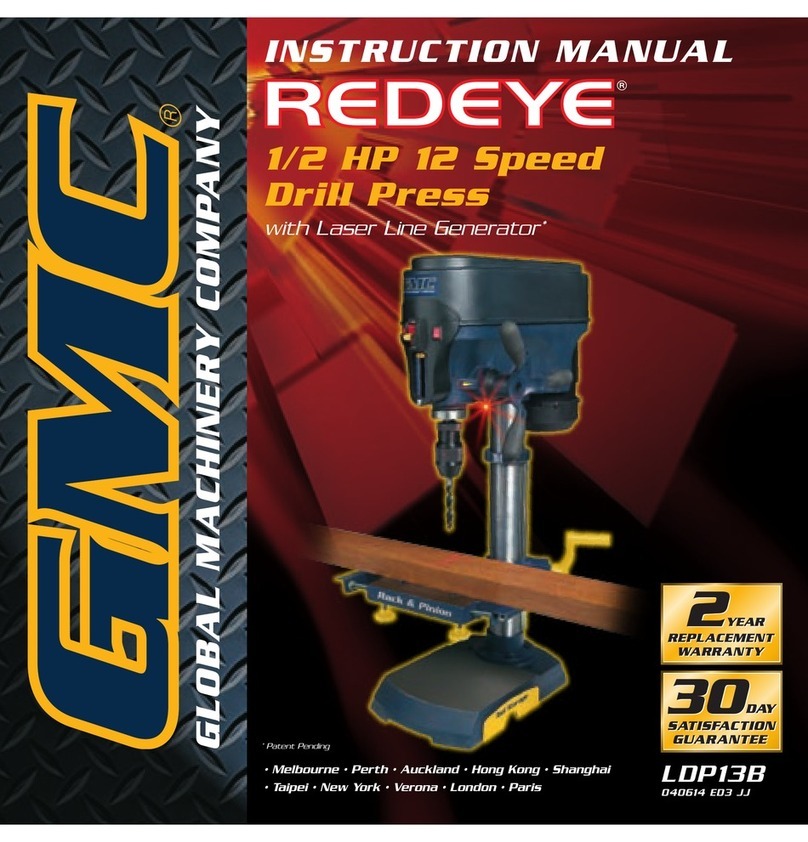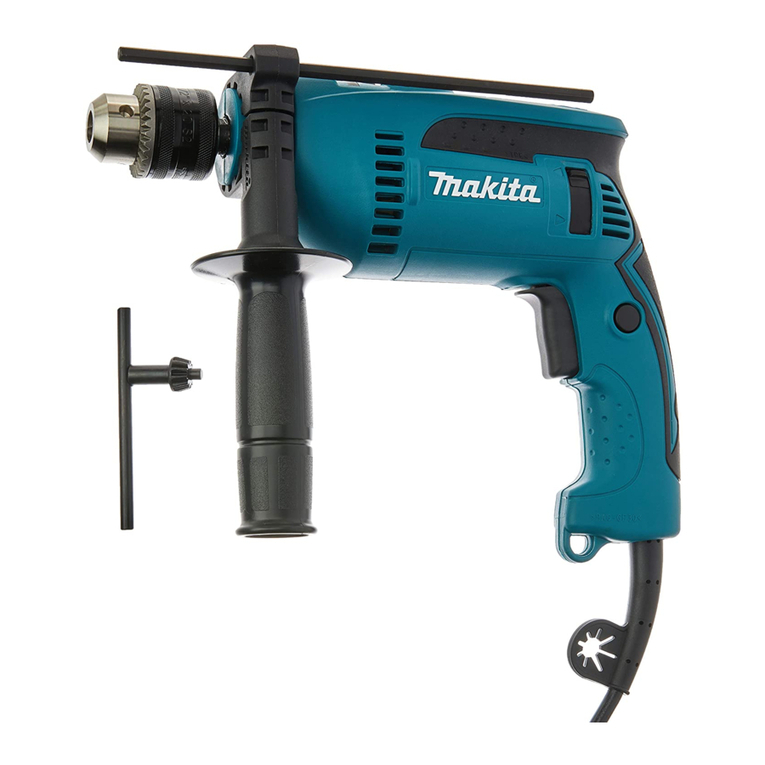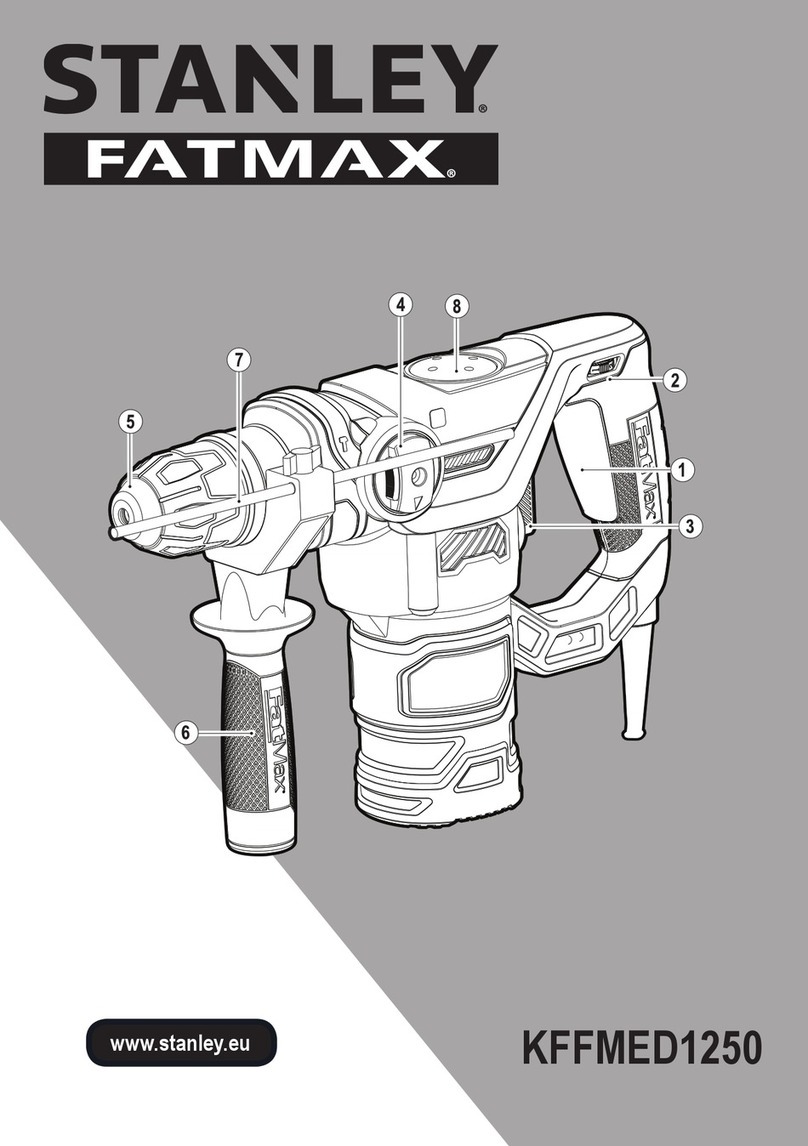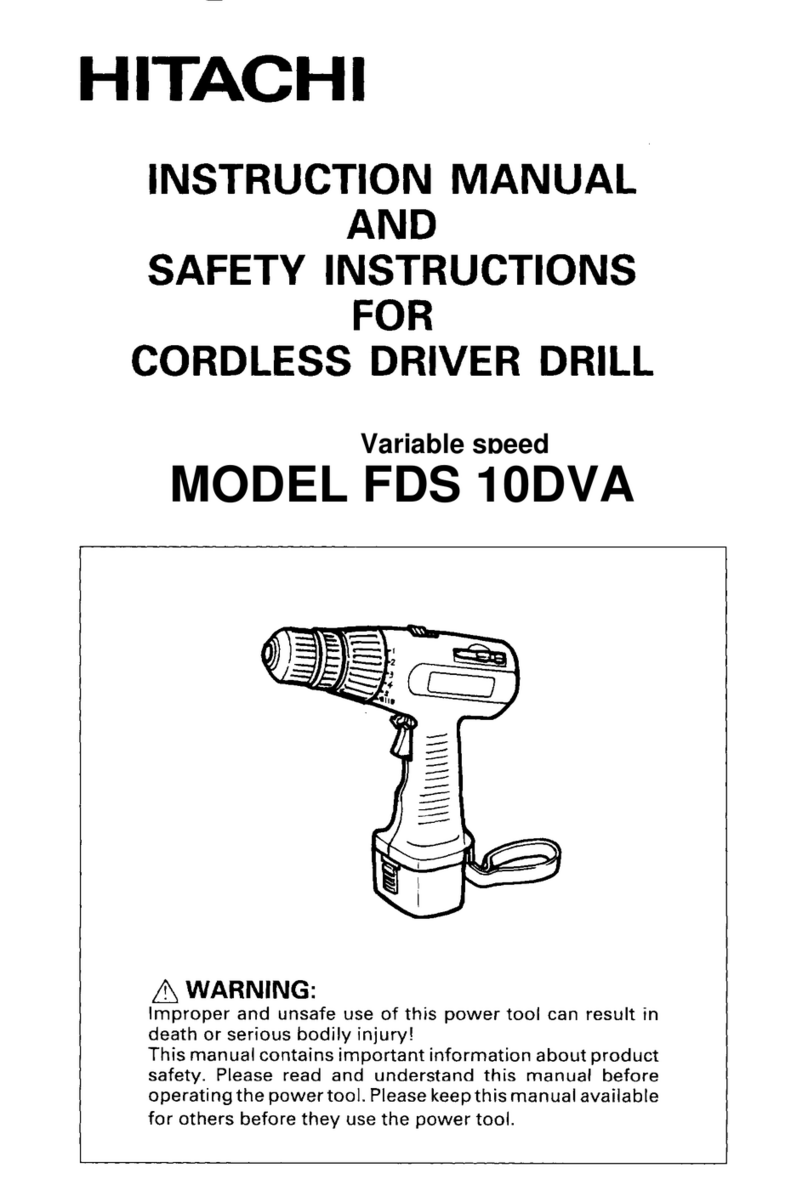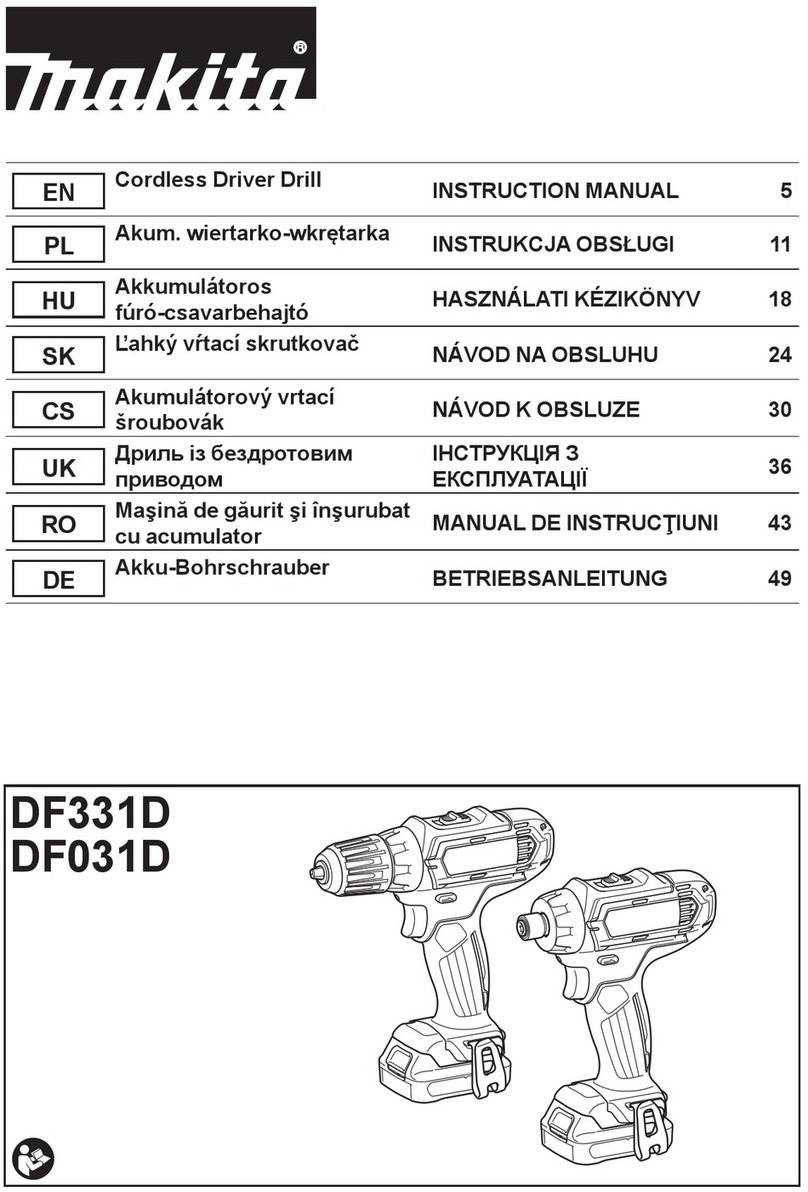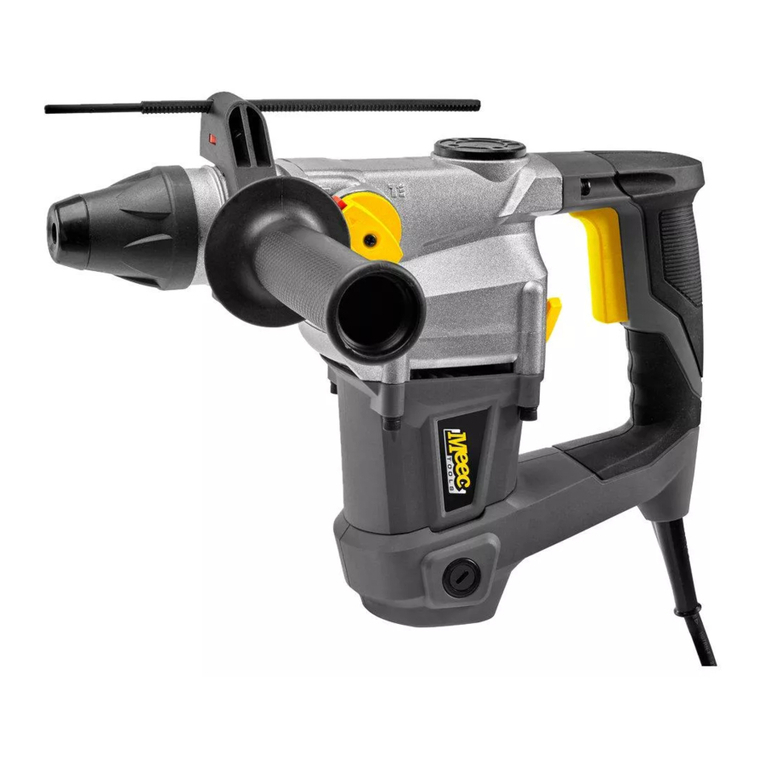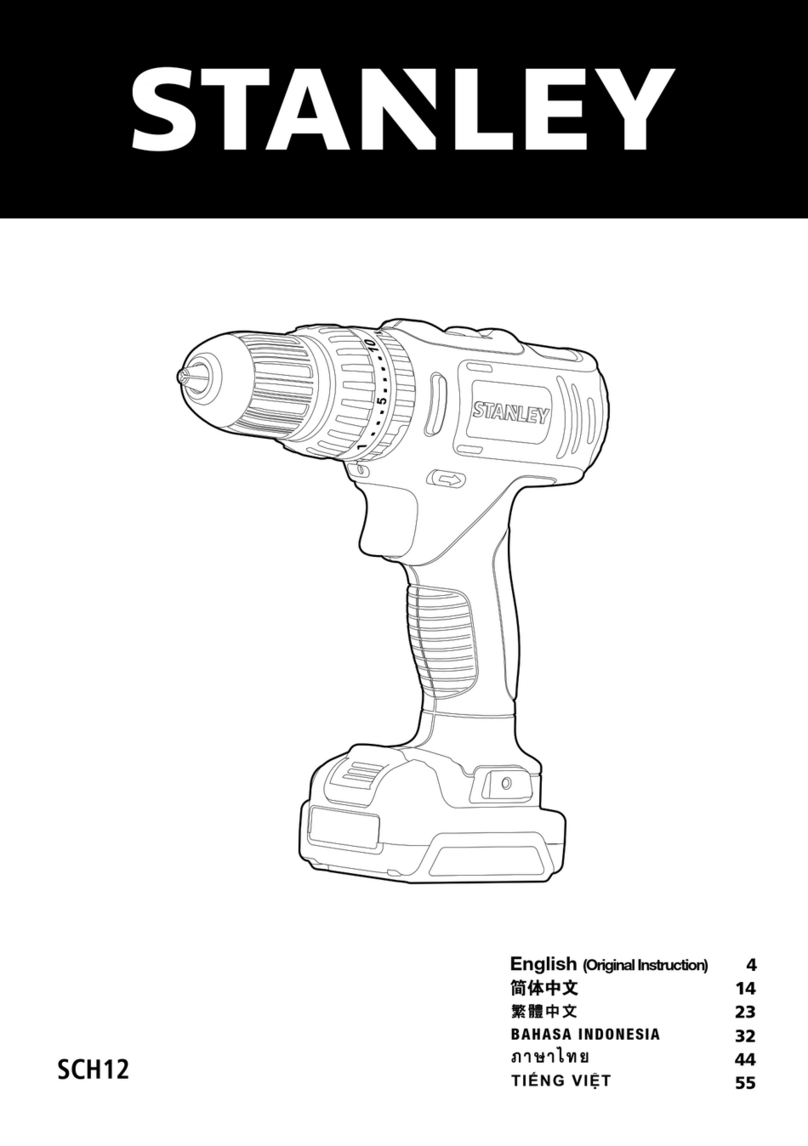Epiroc RD 100 Maintenance and service guide

RD 100
Safety and operating instructions
Rock drills
© Construction Tools PC AB | 98001365 01 | 2020-09-24
Original Instructions
Interactive and updated spare part catalogues go to:
www.epiroc.com/docmine
For log in details please contact your local Epiroc office or dealer in your area
Static PDF spare part catalogues go to:
www.podshop.se/epiroc


Contents
© Construction Tools PC AB | 98001365 01 | 2020-09-24
Original Instructions
3
Table of Contents
1 Introduction ................................................................................................................................6
2 About the Safety and operating instructions ..........................................................................6
3 Safety instructions.....................................................................................................................6
3.1 Safety signal words ............................................................................................................................................6
3.2 Personal precautions and qualifications ..........................................................................................................6
3.2.1 Installation, storage, maintenance and disposal................................................................................................6
3.2.2 Testing...............................................................................................................................................................6
3.2.3 Personal protective equipment ..........................................................................................................................6
3.2.4 Drugs, alcohol or medication .............................................................................................................................7
3.3 Installation, precautions.....................................................................................................................................7
3.4 Operation, precautions.......................................................................................................................................8
3.5 Maintenance, precautions ................................................................................................................................11
3.6 Storage, precautions ........................................................................................................................................12
4 Overview ...................................................................................................................................12
4.1 Design and function..........................................................................................................................................12
4.1.1 Working principle of a rock drill........................................................................................................................12
4.1.2 Water flushing (RD 100) ..................................................................................................................................12
4.2 Main parts ..........................................................................................................................................................13
4.3 Labels.................................................................................................................................................................13
4.3.1 Data plate ........................................................................................................................................................13
4.3.2 Labels on the accumulator ..............................................................................................................................14
4.3.3 Safety label......................................................................................................................................................14
4.4 Guarantee .........................................................................................................................................................14
5 Installation ................................................................................................................................14
5.1 Hoses and connections....................................................................................................................................14
5.2 Hoses .................................................................................................................................................................14
5.3 Quick-release couplings...................................................................................................................................15
5.4 Hydraulic oil.......................................................................................................................................................15
5.5 Methods to prevent freezing ............................................................................................................................15
5.6 Pressure adjustment.........................................................................................................................................15
5.6.1 Hydraulic oil pressure ......................................................................................................................................15
5.6.2 Water pressure ................................................................................................................................................15
5.7 Drill steel ............................................................................................................................................................15
5.7.1 Before fitting the drill steel ...............................................................................................................................16
5.7.2 Changing drill steel ..........................................................................................................................................16
6 Operation ..................................................................................................................................17
6.1 Preparations before starting ............................................................................................................................17
6.1.1 Assemble the handle for different applications (RD 100 RB) ..........................................................................17
6.1.2 Check the drilling equipment ...........................................................................................................................17
6.1.3 Attaching pusher leg to rock drill .....................................................................................................................18
6.2 Controls .............................................................................................................................................................18
6.2.1 Water flushing lever (RD 100) .........................................................................................................................18
6.2.2 Throttle lever (RD 100) ....................................................................................................................................18
6.2.3 Throttle lever (RD 100 RB) ..............................................................................................................................19

Contents
4 © Construction Tools PC AB | 98001365 01 | 2020-09-24
Original Instructions
6.2.4 Twist handle ....................................................................................................................................................19
6.3 Start and stop ....................................................................................................................................................19
6.3.1 Drilling..............................................................................................................................................................19
6.3.2 Starting the rock drill........................................................................................................................................19
6.3.3 Stopping the rock drill ......................................................................................................................................20
6.3.4 Start and stop the rock drill for Roof Bolting version .......................................................................................20
6.4 Operating ...........................................................................................................................................................21
6.4.1 Re-position of the pusher leg...........................................................................................................................21
6.4.2 Flush-cleaning the drill hole (not valid for Roof Bolting version)......................................................................21
6.5 When taking a break .........................................................................................................................................21
7 Maintenance .............................................................................................................................21
7.1 Every day ...........................................................................................................................................................21
7.2 Checking for wear .............................................................................................................................................22
7.3 Replace the drill steel bushings ......................................................................................................................23
7.4 Every 100 hours of operation or 3 times per year..........................................................................................24
8 Troubleshooting.......................................................................................................................25
9 Storage......................................................................................................................................26
10 Disposal ....................................................................................................................................26
11 Technical data ..........................................................................................................................27
11.1 Machine data .....................................................................................................................................................27
11.2 Noise and vibration declaration statement.....................................................................................................27
11.3 Noise and vibration data ..................................................................................................................................28
12 EC Declaration of Conformity .................................................................................................29
12.1 EC Declaration of Conformity (EC Directive 2006/42/EC) .............................................................................29

Contents
© Construction Tools PC AB | 98001365 01 | 2020-09-24
Original Instructions
5

Safety and operating instructions
6 © Construction Tools PC AB | 98001365 01 | 2020-09-24
Original Instructions
1 Introduction
Epiroc is a leading productivity partner for the mining, in-
frastructure and natural resources industries. With cut-
ting-edge technology, Epiroc develops and produces in-
novative drill rigs, rock excavation and construction
equipment, and provides world-class service and con-
sumables.
The company was founded in Stockholm, Sweden, and
has passionate people supporting and collaborating with
customers in more than 150 countries.
Construction Tools PC AB
Box 703
391 27 Kalmar
Sweden
2 About the Safety and
operating instructions
The aim of the instructions is to provide you with knowl-
edge of how to use the rock drill in an efficient, safe way.
The instructions also give you advice and tell you how to
perform regular maintenance on the rock drill.
Before using the rock drill for the first time you must read
these instructions carefully and understand all of them.
3 Safety instructions
To reduce the risk of serious injury or death to yourself
or others, read and understand the Safety and operating
instruction before installing, operating, repairing, main-
taining, or changing accessories on the machine.
Post this Safety and operating instruction at work loca-
tions, provide copies to employees, and make sure that
everyone reads the Safety and operating instruction be-
fore operating or servicing the machine. For professional
use only.
In addition, the operator or the operator's employer must
assess the specific risks that may be present as a result
of each use of the machine.
Save all warnings and instructions for future reference.
3.1 Safety signal words
The safety signal words Danger, Warning and Caution
have the following meanings:
DANGER Indicates a hazardous situation
which, if not avoided, will result in
death or serious injury.
WARNING Indicates a hazardous situation
which, if not avoided, could result in
death or serious injury.
CAUTION Indicates a hazardous situation
which, if not avoided, could result in
minor or moderate injury.
3.2 Personal precautions and
qualifications
Only qualified and trained persons may operate or main-
tain the machine. They must be physically able to handle
the bulk, weight, and power of the tool. Always use your
common sense and good judgement.
3.2.1 Installation, storage, maintenance
and disposal
Installation, storage, maintenance and disposal of the
machine may only be undertaken by persons who:
• are aware of all the relevant national safety instruc-
tions and accident prevention instructions
• and have read and understood the Safety and oper-
ating instructions.
3.2.2 Testing
Testing of the hydraulic installation must only be carried
out by professional technicians. The technicians must be
authorised to approve a hydraulic installation in accor-
dance with national directives.
3.2.3 Personal protective equipment
Always use approved protective equipment. Operators
and all other persons in the working area must wear pro-
tective equipment, including at a minimum:
• Protective helmet
• Hearing protection
• Impact resistant eye protection with side protection
• Respiratory protection when appropriate
• Protective gloves
• Proper protective boots
• Appropriate work overall or similar clothing (not
loose-fitting) that covers your arms and legs.

Safety and operating instructions
© Construction Tools PC AB | 98001365 01 | 2020-09-24
Original Instructions
7
3.2.4 Drugs, alcohol or medication
WARNING Drugs, alcohol or medication
Drugs, alcohol or medication may impair your judgment
and powers of concentration. Poor reactions and incor-
rect assessments can lead to severe accidents or death.
uNever use the machine when you are tired or under
the influence of drugs, alcohol or medication.
uNo person who is under the influence of drugs, alco-
hol or medication may operate the machine.
3.3 Installation, precautions
DANGER Compressed gas, explosion hazard
The accumulator is pressurized even when the hydraulic
system is shut off. To dismount the accumulator without
first releasing the nitrogen gas can cause serious per-
sonal injury or death.
uFill the high-pressure accumulator with nitrogen (N2)
only.
uOnly authorised personnel are qualified to work with
the accumulator.
WARNING Whipping hose
Hoses under pressure can whip uncontrollably if screws
loosen or are loosened. A whipping hose can cause se-
vere injuries. To reduce this risk:
uDepressurise the system before loosening the con-
nection of a hose.
uTighten the nuts on the connections of the hoses to
required torque.
uCheck that the hose and the connections are not
damaged.
uNever carry the machine by the hoses.
WARNING Hydraulic oil at high pressure
Thin jets of hydraulic oil under high pressure can pene-
trate the skin and cause permanent injury.
uImmediately consult a doctor if hydraulic oil has pen-
etrated the skin.
uNever use your fingers to check for hydraulic fluid
leaks.
uKeep your face away from any possible leaks.
WARNING Hydraulic oil
Spilled hydraulic oil can cause burns, accidents due to
slippery conditions and will also harm the environment.
uTake care of all spilled oil and handle it according to
your safety and environmental regulations.
uNever dismount the hydraulic machine when the hy-
draulic oil is hot.
uNever run any hydraulic lines for attachment of the
hydraulic machine through the drivers cab.
WARNING Ejected working tool
If the tool retainer on the machine is not in a locked posi-
tion, the working tool can be ejected with force, which
can cause personal injury.
uNever start the machine while changing the working
tool.
uBefore changing the working tool or accessories,
stop the machine and turn off the power source.
uNever point the working tool at yourself or anyone
else.
uMake sure that the working tool is fully inserted and
the tool retainer is in a locked position before the ma-
chine is started.
uCheck the locking function by pulling the working tool
outwards forcefully.
WARNING Moving or slipping insertion tool
An incorrect dimension of the inserted tool’s shank can
result in that the inserted tool is lost or is slipping out
during operation. Risk of severe injury or crushed hands
and fingers.
uCheck that the insertion tool has the shank length
and dimensions that the machine is intended for.
uNever use an insertion tool without a collar.
WARNING Injured hands
There is a risk of injured fingers when mounting the
pusher leg on the rock drill. To recuce this risk:
uNever inspect, clean, install, or remove the pusher
leg while the power source is connected.
uNever put the fingers between the rock drill and
pusher leg attachment.
CAUTION Skin eczema
Hydraulic oil can cause eczema if it comes in contact
with the skin.
uAvoid getting hydraulic oil on your hands.
uAlways use protective gloves when working with hy-
draulic oil.
uWash hands after contact with hydraulic oil.

Safety and operating instructions
8 © Construction Tools PC AB | 98001365 01 | 2020-09-24
Original Instructions
CAUTION Moving parts
Risk for crushed hands and fingers.
uNever check bores or passages with hands or fin-
gers.
3.4 Operation, precautions
DANGER Explosion hazard
If a warm insertion tool comes into contact with explo-
sives, an explosion could occur. During operation with
certain materials as well as use of certain materials in
machine parts, sparks and ignition can occur. Explosions
will lead to severe injuries or death.
uNever operate the machine in any explosive environ-
ment.
uNever use the machine near flammable materials,
fumes or dust.
uMake sure that there are no undetected sources of
gas or explosives.
uNever drill in an old hole.
DANGER Electrical hazard
The machine is not electrically insulated. If the machine
comes into contact with electricity, serious injuries or
death may result.
uNever operate the machine near any electric wire or
other source of electricity.
uMake sure that there are no concealed wires or other
sources of electricity in the working area.
WARNING Operating pressure
If the maximum operating pressure for the hydraulic ma-
chine is exceeded, the accumulator can be over charged
which can result in material damage and personal injury.
uAlways run the hydraulic machine with the correct
operating pressure. See "Technical data".
WARNING Unexpected movements
The working tool is exposed to heavy strains when the
machine is used. The working tool may break due to fa-
tigue after a certain amount of use. If the working tool
breaks or gets stuck, there may be sudden and unex-
pected movement that can cause injuries. Furthermore,
losing your balance or slipping may cause injury.
uMake sure that you always keep a stable position
with your feet as far apart as your shoulder width,
and keeping a balanced body weight.
uAlways inspect the equipment prior to use. Never
use the equipment if you suspect that it is damaged.
uMake sure that the handles are clean and free of
grease and oil.
uKeep your feet away from the working tool.
uStand firmly and always hold on to the machine with
both hands.
uNever drill in an old hole.
uNever start the machine when it is lying on the
ground.
uNever ‘ride’ on the machine with one leg over the
handle.
uNever strike or abuse the equipment.
uCheck regularly for wear on the working tool, and
check whether there are any signs of damage or visi-
ble cracks.
uPay attention and look at what you are doing.
WARNING Stalling hazard
If the working tool gets caught during operation, the
whole machine may will start to rotate if you lose your
grip on it. This unexpected rotation of the entire machine
may cause serious injury.
uStand firmly and always hold onto the machine with
both hands.
uMake sure that the handle or handles are clean and
free from grease and oil.
uNever drill in an old hole.
WARNING Trapping hazard
There is risk of neck ware, hair, gloves and clothes get-
ting dragged into or caught by a rotating insertion tool or
accessories. This may cause choking, scalping, lacera-
tions or death. To reduce the risk:
uNever grab or touch a rotating drill steel.
uAvoid wearing clothing, neck ware or gloves that may
get caught.
uCover long hair with a hair net.
There is risk of getting trapped between the machine
and the roof/wall should the machine, for any reason, tip
over. There is also risk for crushed hands and fingers
when extending the pusher leg.

Safety and operating instructions
© Construction Tools PC AB | 98001365 01 | 2020-09-24
Original Instructions
9
WARNING Dust and fume hazard
Dusts and/or fumes generated or dispersed when using
the machine may cause serious and permanent respira-
tory disease, illness, or other bodily injury (for example,
silicosis or other irreversible lung disease that can be fa-
tal, cancer, birth defects, and/or skin inflammation).
Some dusts and fumes created by drilling, breaking,
hammering, sawing, grinding and other construction ac-
tivities contain substances known to the State of Califor-
nia and other authorities to cause respiratory disease,
cancer, birth defects, or other reproductive harm. Some
examples of such substances are:
uCrystalline silica, cement, and other masonry products.
uArsenic and chromium from chemically-treated rubber.
uLead from lead-based paints.
Dust and fumes in the air can be invisible to the naked
eye, so do not rely on eye sight to determine if there is
dust or fumes in the air.
To reduce the risk of exposure to dust and fumes, do all
of the following:
uPerform site-specific risk assessment. The risk as-
sessment should include dust and fumes created by
the use of the machine and the potential for disturb-
ing existing dust.
uUse proper engineering controls to minimize the
amount of dust and fumes in the air and to minimize
build-up on equipment, surfaces, clothing, and body
parts. Examples of controls include: exhaust ventila-
tion and dust collection systems, water sprays, and
wet drilling. Control dusts and fumes at the source
where possible. Make sure that controls are properly
installed, maintained and correctly used.
uWear, maintain and correctly use respiratory protec-
tion as instructed by your employer and as required
by occupational health and safety regulations. The
respiratory protection must be effective for the type
of substance at issue (and if applicable, approved by
relevant governmental authority).
uWork in a well ventilated area.
uIf the machine has an exhaust, direct the exhaust so
as to reduce disturbance of dust in a dust filled envi-
ronment.
uOperate and maintain the machine as recommended
in the operating and safety instructions
uSelect, maintain and replace consumables/ working
tools/ other accessories as recommended in the op-
erating and safety instructions. Incorrect selection or
lack of maintenance of consumables/ inserted tools/
other accessories may cause an unnecessary in-
crease in dust or fumes.
uWear washable or disposable protective clothes at
the worksite, and shower and change into clean
clothes before leaving the worksite to reduce expo-
sure of dust and fumes to yourself, other persons,
cars, homes, and other areas.
uAvoid eating, drinking, and using tobacco products in
areas where there is dust or fumes.
uWash your hands and face thoroughly as soon as
possible upon leaving the exposure area, and always
before eating, drinking, using tobacco products, or
making contact with other persons.
uComply with all applicable laws and regulations, in-
cluding occupational health and safety regulations.
uParticipate in air monitoring, medical examination
programs, and health and safety training programs
provided by your employer or trade organizations
and in accordance with occupational health and
safety regulations and recommendations. Consult
with physicians experienced with relevant occupa-
tional medicine.
uWork with your employer and trade organization to
reduce dust and fume exposure at the worksite and
to reduce the risks. Effective health and safety pro-
grams, policies and procedures for protecting work-
ers and others against harmful exposure to dust and
fumes should be established and implemented
based on advice from health and safety experts.
Consult with experts.
uResidues of hazardous substances on the machine
can be a risk. Before undertaking any maintenance
on the machine, clean it thoroughly.
WARNING Hot water hazard
The flushing water can become hot and cause burns. To
reduce the risk of burns:
uKeep your body away from the hot water.
uStop the machine and the power source immediately.
uWait until the machine and power source has cooled
down before carrying out maintenance work.
WARNING Projectiles
Failure of the work piece, of accessories, or even of the
machine itself may generate high velocity projectiles.
During operating, splinters or other particles from the

Safety and operating instructions
10 © Construction Tools PC AB | 98001365 01 | 2020-09-24
Original Instructions
working material may become projectiles and cause per-
sonal injury by striking the operator or other persons. To
reduce these risk:
uUse approved personal protective equipment and
safety helmet, including impact resistant eye protec-
tion with side protection.
uMake sure that no unauthorised persons trespass
into the working zone.
uKeep the workplace free from foreign objects.
uEnsure that the work piece is securely fixed.
WARNING Splinters hazard
Using the insertion tool as a hand struck tool can result
in splinters hitting the operator and can cause personal
injury.
uNever use an insertion tool as a hand struck tool.
They are specifically designed and heat-treated to be
used only in a machine.
WARNING Slipping, tripping and falling hazards
There is a risk of slipping, tripping or falling, for example
tripping on hoses or on other objects. Slipping, tripping
or falling can cause injury. To reduce this risk:
uAlways make sure that no hose or other object is in
your way or in any other person's way.
uAlways make sure you are in a stable position with
your feet as far apart as your shoulder width and
keeping a balanced body weight.
WARNING Motion hazards
When using the machine to perform work-related activi-
ties, you may experience discomfort in the hands, arms,
shoulders, neck, or other parts of the body.
uAdopt a comfortable posture while maintaining se-
cure footing and avoiding awkward off-balanced pos-
tures.
uChanging posture during extended tasks may help
avoid discomfort and fatigue.
uIn case of persistent or recurring symptoms, consult
a qualified health professional.
WARNING Vibration hazards
Normal and proper use of the machine exposes the op-
erator to vibration. Regular and frequent exposure to vi-
bration may cause, contribute to, or aggravate injury or
disorders to the operator’s fingers, hands, wrists, arms,
shoulders and/or nerves and blood supply or other body
parts, including debilitating and/or permanent injuries or
disorders that may develop gradually over periods of
weeks, months, or years. Such injuries or disorders may
include damage to the blood circulatory system, damage
to the nervous system, damage to joints, and possibly
damage to other body structures.
If numbness, persistent recurring discomfort, burning
sensation, stiffness, throbbing, tingling, pain, clumsiness,
weakened grip, whitening of the skin, or other symptoms
occur at any time, when operating the machine or when
not operating the machine, stop operating the machine,
tell your employer and seek medical attention. Continued
use of the machine after the occurrence of any such
symptom may increase the risk of symptoms becoming
more severe and/or permanent.
Operate and maintain the machine as recommended in
these instructions, to prevent an unnecessary increase
in vibration.
The following may help to reduce exposure to vibration
for the operator:
uLet the machine do the job. Use a minimum hand
grip consistent with proper control and safe opera-
tion.
uIf the machine has vibration absorbing handles, keep
them in a central position, avoid pressing the handles
into the end stops.
uWhen the percussion mechanism is activated, the
only body contact with the machine you should have
are your hands on the handle or handles. Avoid any
other contact, for example supporting any part of the
body against the machine or leaning onto the ma-
chine trying to increase the feed force. It is also im-
portant not to keep the start and stop device en-
gaged while extracting the machine from the broken
work surface.
uMake sure that the working tool is well-maintained ,
not worn out, and of the proper size. Working tools
that are not well-maintained, or that are worn out, or
that are not of the proper size result in longer time to
complete a task (and a longer period of exposure to
vibration) and may result in or contribute to higher
levels of vibration exposure.
uImmediately stop working if the machine suddenly
starts to vibrate strongly. Before resuming the work,
find and remove the cause of the increased vibra-
tions.
uNever grab, hold or touch the chuck, drill stell or drill
bit when using the machine.
uParticipate in health surveillance or monitoring, medi-
cal exams and training programs offered by your em-
ployer and when required by law.
uWhen working in cold conditions wear warm clothing
and keep hands warm and dry.

Safety and operating instructions
© Construction Tools PC AB | 98001365 01 | 2020-09-24
Original Instructions
11
WARNING Vibration hazard
Using inserted tools that do not fulfil the criteria men-
tioned below, will result in a longer time to complete a
task, and may result in higher levels of vibration expo-
sure. A worn tool will also cause increased working time.
uMake sure that the inserted tool is well-maintained,
not worn out and of the proper size.
uAlways use a sharp tool in order to work efficiently.
WARNING Concealed object hazard
During operating, concealed wires and pipes constitute a
danger that can result in serious injury.
uCheck the composition of the material before operat-
ing.
uWatch out for concealed cables and pipes for exam-
ple electricity, telephone, water, gas and sewage
lines etc.
uIf the inserted tool seems to have hit a concealed ob-
ject, switch off the machine immediately.
uMake sure that there is no danger before continuing.
WARNING Involuntary start
Involuntary start of the machine may cause injury.
uKeep your hands away from the start and stop de-
vice until you are ready to start the machine.
uLearn how the machine is switched off in the event of
an emergency.
uStop the machine immediately in all cases of power
supply interruption.
WARNING Noise hazard
High noise levels can cause permanent and disabling
hearing loss and other problems such as tinnitus (ring-
ing, buzzing, whistling, or humming in the ears). To re-
duce risks and prevent an unnecessary increase in noise
levels:
uRisk assessment of these hazards and implementa-
tion of appropriate controls is essential.
uOperate and maintain the machine as recommended
in these instructions.
uSelect, maintain and replace the working tool as rec-
ommended in these instructions.
uIf the machine has a silencer, check that it is in place
and in good working condition.
uAlways use hearing protection.
uUse damping material to prevent work pieces from
'ringing'.
WARNING Choose right power pack
Handheld hydraulic rock drills are designed for working
together with Epiroc power packs. Use of other power
sources can lead to personal injury and damage of the
machine.
uMake sure that the power source you plan to use is
compatible with the rock drill, see section "Technical
data".
CAUTION Idling strokes
Prolonged idling strokes can cause damage on percus-
sion unit of the rock drill.
uStop the rock drill immediately after the drilling is
done.
3.5 Maintenance, precautions
WARNING Machine modification
Any machine modification may result in bodily injuries to
yourself or others.
uNever modify the machine. Modified machines are
not covered by warranty or product liability.
uAlways use approved original parts, tools, and ac-
cessories.
uChange damaged parts immediately.
uReplace worn components in good time.
WARNING Working tool hazards
Accidental engagement of the start and stop device dur-
ing maintenance or installation can cause serious in-
juries, when the power source is connected.
uNever inspect, clean, install, or remove the working
tool while the power source is connected.

Safety and operating instructions
12 © Construction Tools PC AB | 98001365 01 | 2020-09-24
Original Instructions
CAUTION Hot working tool
The tip of the working tool can become hot and sharp
when used. Touching it can lead to burns and cuts.
uNever touch a hot or sharp working tool.
uWait until the working tool has cooled down before
carrying out maintenance work.
3.6 Storage, precautions
nKeep the machine and tools in a safe place, out of
the reach of children and locked up.
4 Overview
To reduce the risk of serious injury or death to your-
self or others, read the Safety instructions section
found on the previous pages of this manual before
operating the machine.
4.1 Design and function
RD 100 is a sturdy and reliable handheld hydraulic rock
drill designed for working together with pusher leg, PL
100, and with power pack, PP 100. The pusher leg sup-
port helps the operator to lift and feed the rock drill dur-
ing the drilling operation.
There are no limitations on the ambient temperature on
the working place as soon as the used hydraulic fluid are
within the needed parameters. The temperature of the
hydraulic fluid and the hydraulic power are regulated by
the PP 100.
RD 100 is designed for drilling of blast holes, anchor
holes, and for test drillings in for example granite and
concrete. It is suited for hole diameters from Ø 25-42
mm (1-111/16 in.) and will, when using hollow drill steels
of the ISO-series 11-17, work efficiently down to a maxi-
mum depth of2.4 m (7.9 ft), depending on the material.
The drilling dust is removed from the drill hole by means
of flushing water.
No other use is permitted. To choose the correct working
tool, see the spare part list.
A built-in torque limiter ensures that the operator can
hold the rock drill, if the drill steel gets stuck.
The rock drill is delivered with tail-hoses with 'Flat-Face'
quick-release couplings for easy connection to the
Epiroc power pack.
4.1.1 Working principle of a rock drill
Impact Feed force Rotation Flushing
4.1.2 Water flushing (RD 100)
Water flushing is used to transport the drill grit out of the
hole and it has also a reducing effect of dust and fumes.
Water flushing is ducted through the anvil to the drilling
steel. The water flushing engages as soon as the rock
drill is turned on. On RD 100 it is also possible to manu-
ally adjust the water flushing flow with a lever and also
manually activate continuous flushing with a lever on the
side of the machine . Note these features are not avail-
able on RD 100 RB.
The water hose is connected via the power pack to the
rock drill and the pusher leg.

Safety and operating instructions
© Construction Tools PC AB | 98001365 01 | 2020-09-24
Original Instructions
13
4.2 Main parts
A
B
C
D
E
F
G
I
RD 100
H
D
C
EF
G
RD 100 RB
A. Manually water flushing
B. Water flushing adjust
C. Pusher leg locking lever
D. Throttle lever
E. Water inlet
F. Oil return line
G. Oil pressure line
H. Roof bolting handle
I. Twist handle, feed control lever
JK
L
M
J. Machine attachment
K. Front support handle
L. Outlet water from the pusher leg
M. Drill steel retainer
4.3 Labels
The machine is fitted with labels containing important in-
formation about personal safety and machine mainte-
nance. The labels must be in such condition that they
are easy to read. New labels can be ordered from the
spare parts list.
4.3.1 Data plate
ABC
DEFG
H
A. Machine type
B. Serial number
C. Maximum permitted hydraulic pressure
D. Maximum nominal operating pressure
E. Oil consumption
F. The warning symbol together with the book symbol
means that the user must read the safety and oper-
ating instructions before the machine is used for the
first time.
G. The CE symbol means that the machine is EC-ap-
proved. See the EC declaration which is delivered
with the machine for more information. If the CE
symbol is missing, it means that the machine is not
EC-approved.
H. The EAC symbol means that the machine is EAC
approved.

Safety and operating instructions
14 © Construction Tools PC AB | 98001365 01 | 2020-09-24
Original Instructions
4.3.2 Labels on the accumulator
2
N
The accumulator must only be charged with Nitrogen.
NOTICE Only certified personnel are allowed to work
with the accumulator.
4.3.3 Safety label
To avoid injury, before using or servicing tool, read and
understand separately provided safety instructions.
4.4 Guarantee
The guarantee or product liability will be invalidated by
the following:
• Use other than intended
• Maintenance work not being carried out or being
carried out incorrectly
• The use of the wrong consumables
• The use of non-approved parts
• Damage due to wear
• Special applications without the required safety facil-
ities
• Damage due to improper storage
• Changes not carried out by or in consultation with
the manufacturer
5 Installation
WARNING Whipping hose
Hoses under pressure can whip uncontrollably if the
hose connection becomes loose. A whipping hose can
cause severe injuries. To reduce this risk:
uTurn of the power pack before loosening the connec-
tion of a hose.
uCheck that the hose and the connections are not
damaged.
uNever carry or drag the machine by the hoses.
5.1 Hoses and connections
CD
E
A
B
A. Power pack, PP 100.
B. Maximum 30 meter (98 ft) hydraulic hose between
the power pack and the rock drill.
C. Water hose connected to the power pack.
D. Oil pressure line.
E. Oil return line.
nCheck that the correct recommended operating pres-
sure is used, 120 bar (1,740 psi).
nWipe all couplings clean before connecting to the ma-
chine.
nCheck that the rock drill is in stop mode before start-
ing the power pack.
5.2 Hoses
The hydraulic hose must be approved for a working
pressure of at least 240 bar (3,480 psi), for connection to
the machine.

Safety and operating instructions
© Construction Tools PC AB | 98001365 01 | 2020-09-24
Original Instructions
15
Choose the correct dimension and length for the hy-
draulic hose. For hose lengths up to 30 meters, a hose
with a minimum internal diameter of 16 mm (⅝ in.) must
be used. To choose the correct hose, see the spare
parts list.
To resist exterior wear and tear, we recommend using a
2-layer hydraulic hose. The machine connection marked
P (pump) is the oil inlet, and the connection marked T
(tank) is the oil outlet. Always fill up the hydraulic hoses
with oil and circulate it before connecting the rock drill.
Use a pump to circulate the oil, see the spare parts list.
Connect both hoses and make sure that all hose con-
nections are tight. Never carry the machine by the hose.
NOTICE Attach the return line hose and the pressure
line hose according to matching colors. The red color is
for the pressure line, the blue color is for the return line.
5.3 Quick-release couplings
The original hydraulic hoses are fitted with Flat-Face
quick-release couplings that are strong and easy to
clean. The quick-release couplings are fitted so that the
male connection supplies oil and the female connection
receives oil.
NOTICE Wipe all couplings clean before connecting. En-
sure that couplings are clean and correctly engaged be-
fore operation. Failure to do so may result in damage to
the quick couplings and cause overheating and cause
foreign matter to enter the hydraulic system.
5.4 Hydraulic oil
In order to protect the environment, use of biologically
degradable and flame proof hydraulic oil (HFD-U) is rec-
ommended. No other fluids must be used.
nViscosity (preferred) 40-60 cSt. at working tempera-
ture.
Make sure to only use clean oil and filling equipment.
When the machine is used continuously, the oil tempera-
ture will stabilise at a level which is called the working
temperature. This will, depending on the type of work
and the cooling capacity of the hydraulic system, be be-
tween 20-40°C (68-104°F) above the ambient tempera-
ture. At working temperature, the oil viscosity must be
within the preferred limits. The viscosity index indicates
the connection between viscosity and temperature. A
high viscosity is therefore preferred, because the oil can
then be used within a wider temperature range. The ma-
chine must not be used, if oil viscosity fails to remain
within the permitted area, or if the working temperature
of the oil does not fall between 20°C (68°F) and 60°C
(140°F).
5.5 Methods to prevent freezing
If the rock drill freeze, never heat it to melt the ice. Al-
ways let the ice melt at room temperature.
Never pour methylated spirits or similar substances into
the rock drill, as they will interfere with the lubrication
and lead to increased wear.
If the temperature is below 0 °C, blow out the water hose
with compressed air before storage to avoid frost expan-
sion.
NOTICE Maximum allowable air pressure is 7 Bar.
5.6 Pressure adjustment
5.6.1 Hydraulic oil pressure
The hydraulic oil pressure is regulated by the PP 100.
Ensure that it can deliver the required oil pressure of
100-120 bar (1,450 – 1,740 psi) to the machine.
nToo high pressure causes rough operation and ex-
cessive wear.
nToo low pressure results in a slow drilling speed.
5.6.2 Water pressure
The water pressure is regulated by the PP 100. The in-
coming pressure to the PP 100 must be between 5 - 7
bar (73 - 102 psi) at a flow rate of 12 l.p.m (2.6 UK gal/
min) to obtain good water flushing and good functionality
on the pusher leg.
5.7 Drill steel
WARNING Running power pack
Changing the drill steel or accessories while the power
pack is running can cause serious injury.
uShut off the power pack and disconnect the hydraulic
hoses during mounting or dismounting of the drill
steel.
uSecure the power pack against involuntary activa-
tion.

Safety and operating instructions
16 © Construction Tools PC AB | 98001365 01 | 2020-09-24
Original Instructions
5.7.1 Before fitting the drill steel
Check that the tool shank is of the correct size and
length for the chuck used. The tool shank must be clean
and the drill steel must be in good condition. Tool shanks
which are chipped, rounded, out of square, or too hard
on the striking end will operate inefficiently and cause
premature piston failure.
Inspect the drill steel: A dull drill steel will slow down the
drilling speed and overstrain the drill mechanism. When
changing drill steel make sure that the new one is of the
correct size to follow the previous bore.
Before drilling, check that the flushing hole in the drill
steel is not blocked.
WARNING Ejected drill steel
If the tool retainer on the machine is not in a locked posi-
tion, the drill steel can be ejected with force, which can
cause personal injury.
uNever start the machine while changing the drill
steel.
uBefore changing the drill steel or accessories, stop
the machine and turn off the power source.
uNever point the drill steel at yourself or anyone else.
uMake sure that the drill steel is fully inserted and the
tool retainer is in a locked position before the ma-
chine is started.
uCheck the locking function by pulling the drill steel
outwards forcefully.
WARNING Vibration hazard
Using inserted tools that do not fulfil the criteria men-
tioned below, will result in a longer time to complete a
task, and may result in higher levels of vibration expo-
sure. A worn tool will also cause increased working time.
uMake sure that the inserted tool is well-maintained,
not worn out and of the proper size.
uAlways use a sharp tool in order to work efficiently.
WARNING Injured hands
There is a risk of crushing fingers when changing the
drill steel. To recuce this risk:
uNever inspect, clean, install, or remove the working
tool while the power source is connected.
uNever put the fingers between the drill steel retainer
and the chuck.
CAUTION Hot drill steel
The tip of the drill steel can become hot and sharp when
used. Touching it can lead to burns and cuts.
uNever touch a hot or sharp drill steel.
uWait until the drill steel has cooled down before car-
rying out maintenance work.
NOTICE Never cool a hot insertion tool in water, it can
result in brittleness and early failure.
5.7.2 Changing drill steel
Whenever changing a drill steel the following instructions
must be observed. Also, make sure that the tool retainer
is of the proper size.
1. When removing the drill steel. Push the tool retainer
outwards, ensure that the tool retainer is fully up.
2. Insert the drill steel in the chuck.

Safety and operating instructions
© Construction Tools PC AB | 98001365 01 | 2020-09-24
Original Instructions
17
3. When the drill steel bottoms, push back the tool re-
tainer to lock it.
6 Operation
WARNING Involuntary start
Involuntary start of the machine may cause injury.
uKeep your hands away from the start and stop de-
vice until you are ready to start the machine.
uLearn how the machine is switched off in the event of
an emergency.
uStop the machine immediately in all cases of power
supply interruption.
CAUTION Idling strokes
Prolonged idling strokes can cause damage on percus-
sion unit of the rock drill.
uStop the rock drill immediately after the drilling is
done.
6.1 Preparations before starting
6.1.1 Assemble the handle for different
applications (RD 100 RB)
For face drilling
For roof bolting
6.1.2 Check the drilling equipment
The following checks must be made before start using
the rock drill. All these checks concern the serviceability
of the rock drill. Some concerns safety:
nClean all labels. Replace any that are missing or can-
not be read.
nInspect the hoses generally for signs of damage.
nInspect the drill steel and drill bit for wear and dam-
age. Do not use an excessively worn or damaged drill
steel.
nInspect the tool retainer for wear and function.
nClose the tool retainer.
nCheck that the flushing holes in the drill steel and drill
bit are not blocked, and that the flushing water flows
through without obstruction.
nThe drill steels must be from the same ISO-series, if
different lengths are used in the same drill hole.
nRemove the protective caps from the quickrelease
couplings.
nEnsure that the hydraulic couplings are clean and
fully serviceable.
nEnsure that the hydraulic hoses are filled with oil.
nConnect the machine.
nEnsure that any power source that are planned to
use is compatible with the rock drill, see section
"Technical data".
nCheck that the rock drill is in stop mode before start-
ing the power source.

Safety and operating instructions
18 © Construction Tools PC AB | 98001365 01 | 2020-09-24
Original Instructions
6.1.3 Attaching pusher leg to rock drill
A
B
1. Make sure that the pin (A) and the machine attach-
ment are clean.
2. Pull out the locking lever (B) and turn counterclock-
wise to lock it in the open position.
3. Mount the pusher leg to the rock drill.
4. Turn the locking lever (B) clockwise to secure the
pusher leg. Make sure that the lever gets pushed all
the way in.
5. Fill the pusher leg with water by extracting and re-
tracting it a few times.
6.2 Controls
6.2.1 Water flushing lever (RD 100)
A
B
+
-1
0
The rock drill is equipped with throttle levers for regulat-
ing the water flushing.
A. Water flushing adjust.
B. Manual water flushing.
6.2.2 Throttle lever (RD 100)
A
A
Adjust the throttle by using the throttle lever as follows:
1. Pull the throttle lever (A) to start and increase the
throttle.

Safety and operating instructions
© Construction Tools PC AB | 98001365 01 | 2020-09-24
Original Instructions
19
2. Press the throttle lever (A) to decrease the throttle
and for stopping the machine.
6.2.3 Throttle lever (RD 100 RB)
A
Adjust the throttle by using the throttle lever as follows:
1. Turn throttle lever (A) upwards to start and increase
the throttle.
2. Turn the throttle lever (A) downwards to decrease the
throttle and for stopping the machine.
6.2.4 Twist handle
B
C
A
Adjust the pusher leg by using the twist handle as fol-
lows:
1. Make sure that the twist handle is in neutral position
(A) when starting the power pack.
2. Turn the twist handle forwards(B) to extract the
pusher leg.
3. Turn the twist handle backwards(C) to retract the
pusher leg.
For roof bolting version, the twist handle is regulated in
Pusher leg
6.3 Start and stop
6.3.1 Drilling
nUse protective shoes, gloves, helmet, ear protectors
and impact resistant eye protection with side protec-
tion.
nStand firmly and always hold the machine with both
hands. Hold one hand on the twist handle (A) and the
other on the front support handle (C).
nHold the inserted tool firmly against the work surface
before starting the machine.
6.3.2 Starting the rock drill
B
AC
1. Check that the drill steel and drill bit are in good con-
dition and properly attached to the rock drill.
2. Check that the tool retainer is locked, so that the drill
steel does not fall out.
3. Start the power source.
4. Adjust the twist handle (A) to give a suitable feed
force for collaring the hole.

Safety and operating instructions
20 © Construction Tools PC AB | 98001365 01 | 2020-09-24
Original Instructions
5. Align the rock drill so that the drill steel touches the
required collaring point. Avoid small irregularities on
the surface, since they break easily and cause either
a wrong working angle or blank firing.
6. Move the throttle lever (B) forward a little, which
starts the water flushing, the percussion and rotation.
7. Press the rock drill firmly against the material to be
drilled. Turn the twist handle to push the rock drill for-
ward by means of the pusher leg. Increase to full
throttle when collaring is under control.
8. Adjust the feed force to ensure that the rock drill runs
regularly.
6.3.3 Stopping the rock drill
B
AC
nPull the throttle lever (B) backwards. This stops the
percussion, rotation, and flushing water.
6.3.4 Start and stop the rock drill for Roof
Bolting version
A
nTurn the throttle lever (A) uppwards to start, and
downwards to stop the rock drill when using roof bolt-
ing version.
Other manuals for RD 100
1
This manual suits for next models
1
Table of contents
Other Epiroc Drill manuals
